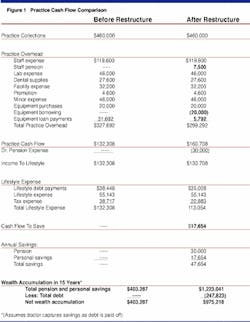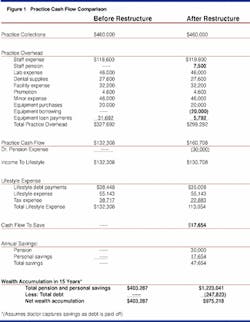Finding savings in debt management
With the proper management of capital purchases and debt, the average doctor can increase his savings by $30,000 to $50,000 per year.
Brian Hufford, CPA, CFP and
James Pride, DDS
In the best-selling book, The Millionaire Next Door, the authors state that doctors, on average, earn more than four times the average American wage earner. Yet, doctors have a very low propensity to accumulate wealth. Why? Through extensive interviews, the authors found that doctors, despite their high incomes, are unable to save a significant amount of money each year.
The authors believe that doctors do not have adequate training in business or personal finance. Nearly all education is centered on clinical issues, with very little training in financial matters. Doctors who are successful at accumulating wealth, according to the authors, save approximately one-third of their practice earnings and commit nearly twice as much time each year as their unsuccessful counterparts in planning and goal-setting.
This two-part article will examine two strategies that we use to assist our clients in saving 25 percent to 40 percent of the practice`s net income. The first part examines the importance of cash flow and the use of debt. The second part will examine effective design of pension plans for your dental practice.
These principles offer some magical results in the ability to accumulate wealth when properly used. However, they must be coupled with effective practice-management techniques and systems to assure that you stay on the road to financial freedom. These systems will be addressed in part three of this series. The whole financial-freedom equation in dentistry is: effective management X effective personal finance = wealth accumulated. This article addresses the effective personal-finance part of the equation.
Improving your savings rate
Are you saving 25percent to 40bpercent of your practice net income? If not, what prevents you from saving a significant amount of money each year? Typically, we hear some form of the following answers:
x- I need to make more.
x- I need to spend less.
x- I am paying too much income tax.
While all three may be true, we have found that the average doctor can increase savings by $30,000 to $50,000 per year from the personal finance side of the wealth equation - merely with the proper management of capital purchases and debt. Dentistry is very capital-intensive. A lack of knowledge about debt management alone can mean the difference between having to work until you die of old age or the ability to achieve financial freedom.
Regarding capital expenditures in dentistry, the prevailing wisdom seems to mirror the philosophy of using consumer debt. This philosophy states that cash should be paid when possible for equipment purchases. If debt must be used, the interest rates should be as low as possible and the length of the loan should be as short as possible.
Figure 2 on page 52 illustrates the issues. This doctor has only three loans. With the extremely low interest rates, it looks as if little improvement could be made in how this debt is structured. However, are interest rates the only issue?
Consider the following additional assumptions:
-This doctor is contemplating expenditures of $20,000 per year for five years for upgrades to computer equipment, office furnishings and equipment.
-The doctor is able to pay cash for these improvements each year.
-The cash flow in the practice and at home is exactly at breakeven with no annual savings.
Are the methods of debt repayment and how capital items are purchased an important issue in dentistry? If so, what are the guiding principles? Most of us would prefer to pay cash rather than to use debt. By using all excess cash in your practice for capital expenditures and rapid repayment of debt, you are exposing yourself to two major problems.
The first problem is that you have no cash in savings for difficult times. The second problem relates to compound growth of savings. A decade of compound growth could be lost while facilitating quick debt repayment. Is there a better and safer way? We believe that there is.
What if we turned the whole debt equation upside down? Why not focus on creating the absolutely lowest monthly payments and the greatest monthly cash flow? What if we could focus on saving that extra cash flow each month and not allow capital or other expenditures to get in the way? Would there be much of a difference in wealth accumulation, income taxes and safety in repaying the debt? To illustrate the differences, we`ve restructured the above debt in Figure 3.
Use loan for capital purchases
Instead of paying cash for the $20,000 of office upgrades and equipment, the doctor used a five-year loan to pay for the annual capital purchases. It may seem crazy to eliminate the low-interest loans that he previously held and replace them with higher interest rate loans. Likewise, why would someone finance $20,000 of equipment each year when he could have paid cash?
However, appearances can be deceiving. Interest rates are not the critical factor. The critical factor is the cash flow that is saved.
What about the slower repayment of debt? Doesn`t that create risk? The risk is the amount of cash in savings, not the amount of debt. Once again, the critical factor is the cash flow that is saved. If an economic depression occurred, it would be important to have cash in savings and low monthly payments.
With a qualified pension plan that is properly designed, the doctor is able to save $30,000 after the debt is restructured, with an additional staff cost of $7,500. The deductible pension plan and debt restructure save $15,834 in federal and state income tax. Because of the tax savings and cash flow from the debt structuring, the doctor has an additional $17,654 to save personally.
The total first-year savings is $30,000 in a pension plan plus $17,654 personally - a total of $47,654. With a better debt structure, the doctor is able to save more than 25 percent of income instantly, where before there was no cash flow available to save. Is this important?
In 20 years, with the debt restructured as outlined above, the implementation of the pension plan and consistent double-digit investment returns, the doctor can accumulate approximately $1,500,000 more in wealth than with the first debt structure. This huge difference is due to the compound-growth process starting five years earlier.
We have a difficult time understanding compound growth. The loss of the first five years of compound growth costs over a million dollars in a 20-year-savings time frame.
Our society promotes a bias against debt that has its roots in personal consumption - autos, department stores, etc. Paying cash for consumer expenditures is a tried-and-true method of preventing overspending. No one can dispute the need to avoid overspending on consumer items. However, for capital expenditures in dentistry, the proper structure of debt can mean the difference between wealth and working until age 75 or beyond.
For maximum wealth accumulation, the three most important principles of debt are:
(1) Structure all business and personal debt in a manner that creates the lowest monthly payments and the maximum cash flow. This may involve using home equity to pay for business loans or for auto loans, or it could mean using longer-term business debt to eliminate credit card debt.
(2) Structure debt so that all interest is tax deductible. Utilize the tax code "tracing rules" to make sure restructured-debt interest is tax deductible.
(3) Save the cash flow diligently when the debt is restructured. Restructuring debt and then spending the difference is harmful. You would be better off prepaying the debt. Restructuring debt only works if you save the cash flow that is produced.
By applying these cash flow and debt principles in our example, we can capture $2,040 per month of reduced debt payments plus $20,000 per year for five years of cash that would have been paid for capital expenditures.
We can commit these cash savings to a deductible pension plan, which will save $15,834 annually in income taxes. The doctor can greatly increase wealth in a shorter period of time with much less stress and financial risk. This result is accomplished, ironically, even with higher interest rates and with higher total interest paid.
Figure 1 on Page 51 illustrates the results of all of the changes.


